Analysis of Sustainability Issues in Canadian Healthcare System
VerifiedAdded on 2022/10/01
|7
|2279
|437
Essay
AI Summary
This essay provides a comprehensive analysis of the sustainability of the Canadian healthcare system. It explores the critical challenges, including rising healthcare expenditures, an aging population, and the inadequate recruitment and retention of nursing and healthcare professionals. The paper discusses the interplay between sustainable healthcare delivery and staffing issues, highlighting the impact of funding models and government policies. It examines the roles of both federal and provincial governments in healthcare funding and delivery, and proposes potential solutions such as collaborative decision-making, improved training programs, and enhanced working conditions for healthcare professionals. The essay draws on statistical data and research findings to support its arguments, ultimately advocating for integrated efforts to ensure the long-term sustainability of the Canadian healthcare system. The paper also discusses the Romanow Commission's recommendations and the need for adjustments in healthcare spending and delivery to address the challenges faced by the Canadian healthcare system.
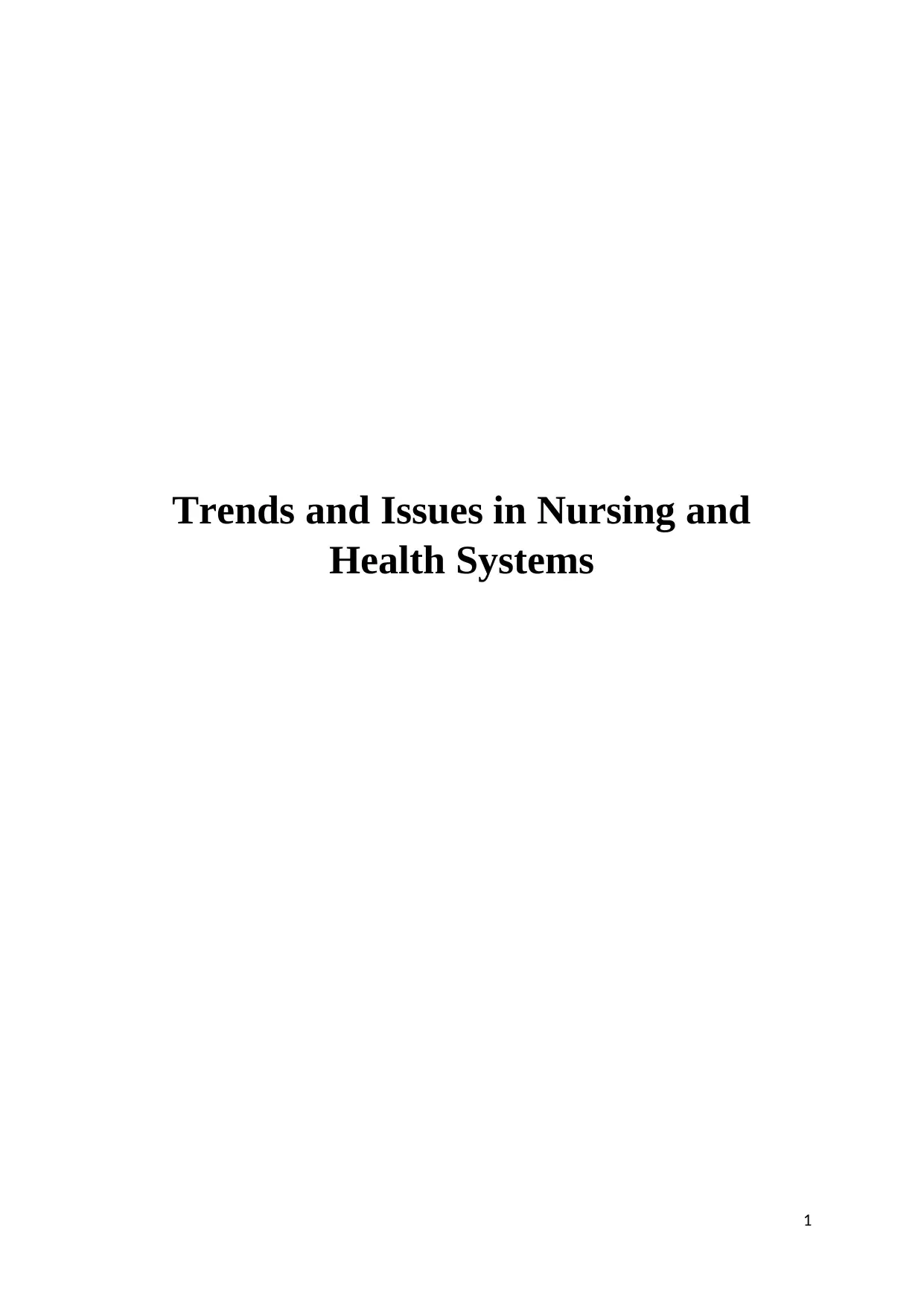
Trends and Issues in Nursing and
Health Systems
1
Health Systems
1
Paraphrase This Document
Need a fresh take? Get an instant paraphrase of this document with our AI Paraphraser
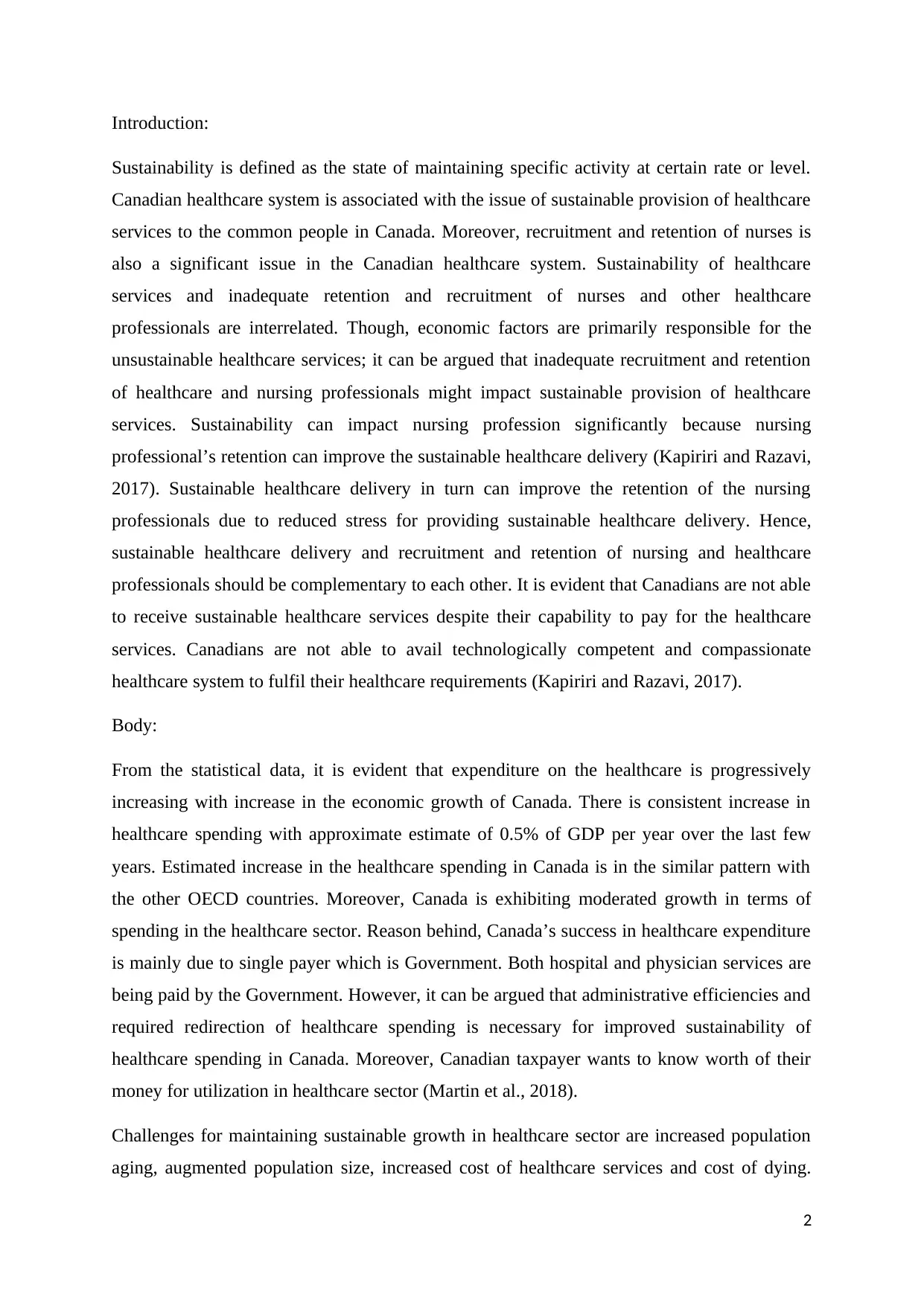
Introduction:
Sustainability is defined as the state of maintaining specific activity at certain rate or level.
Canadian healthcare system is associated with the issue of sustainable provision of healthcare
services to the common people in Canada. Moreover, recruitment and retention of nurses is
also a significant issue in the Canadian healthcare system. Sustainability of healthcare
services and inadequate retention and recruitment of nurses and other healthcare
professionals are interrelated. Though, economic factors are primarily responsible for the
unsustainable healthcare services; it can be argued that inadequate recruitment and retention
of healthcare and nursing professionals might impact sustainable provision of healthcare
services. Sustainability can impact nursing profession significantly because nursing
professional’s retention can improve the sustainable healthcare delivery (Kapiriri and Razavi,
2017). Sustainable healthcare delivery in turn can improve the retention of the nursing
professionals due to reduced stress for providing sustainable healthcare delivery. Hence,
sustainable healthcare delivery and recruitment and retention of nursing and healthcare
professionals should be complementary to each other. It is evident that Canadians are not able
to receive sustainable healthcare services despite their capability to pay for the healthcare
services. Canadians are not able to avail technologically competent and compassionate
healthcare system to fulfil their healthcare requirements (Kapiriri and Razavi, 2017).
Body:
From the statistical data, it is evident that expenditure on the healthcare is progressively
increasing with increase in the economic growth of Canada. There is consistent increase in
healthcare spending with approximate estimate of 0.5% of GDP per year over the last few
years. Estimated increase in the healthcare spending in Canada is in the similar pattern with
the other OECD countries. Moreover, Canada is exhibiting moderated growth in terms of
spending in the healthcare sector. Reason behind, Canada’s success in healthcare expenditure
is mainly due to single payer which is Government. Both hospital and physician services are
being paid by the Government. However, it can be argued that administrative efficiencies and
required redirection of healthcare spending is necessary for improved sustainability of
healthcare spending in Canada. Moreover, Canadian taxpayer wants to know worth of their
money for utilization in healthcare sector (Martin et al., 2018).
Challenges for maintaining sustainable growth in healthcare sector are increased population
aging, augmented population size, increased cost of healthcare services and cost of dying.
2
Sustainability is defined as the state of maintaining specific activity at certain rate or level.
Canadian healthcare system is associated with the issue of sustainable provision of healthcare
services to the common people in Canada. Moreover, recruitment and retention of nurses is
also a significant issue in the Canadian healthcare system. Sustainability of healthcare
services and inadequate retention and recruitment of nurses and other healthcare
professionals are interrelated. Though, economic factors are primarily responsible for the
unsustainable healthcare services; it can be argued that inadequate recruitment and retention
of healthcare and nursing professionals might impact sustainable provision of healthcare
services. Sustainability can impact nursing profession significantly because nursing
professional’s retention can improve the sustainable healthcare delivery (Kapiriri and Razavi,
2017). Sustainable healthcare delivery in turn can improve the retention of the nursing
professionals due to reduced stress for providing sustainable healthcare delivery. Hence,
sustainable healthcare delivery and recruitment and retention of nursing and healthcare
professionals should be complementary to each other. It is evident that Canadians are not able
to receive sustainable healthcare services despite their capability to pay for the healthcare
services. Canadians are not able to avail technologically competent and compassionate
healthcare system to fulfil their healthcare requirements (Kapiriri and Razavi, 2017).
Body:
From the statistical data, it is evident that expenditure on the healthcare is progressively
increasing with increase in the economic growth of Canada. There is consistent increase in
healthcare spending with approximate estimate of 0.5% of GDP per year over the last few
years. Estimated increase in the healthcare spending in Canada is in the similar pattern with
the other OECD countries. Moreover, Canada is exhibiting moderated growth in terms of
spending in the healthcare sector. Reason behind, Canada’s success in healthcare expenditure
is mainly due to single payer which is Government. Both hospital and physician services are
being paid by the Government. However, it can be argued that administrative efficiencies and
required redirection of healthcare spending is necessary for improved sustainability of
healthcare spending in Canada. Moreover, Canadian taxpayer wants to know worth of their
money for utilization in healthcare sector (Martin et al., 2018).
Challenges for maintaining sustainable growth in healthcare sector are increased population
aging, augmented population size, increased cost of healthcare services and cost of dying.
2
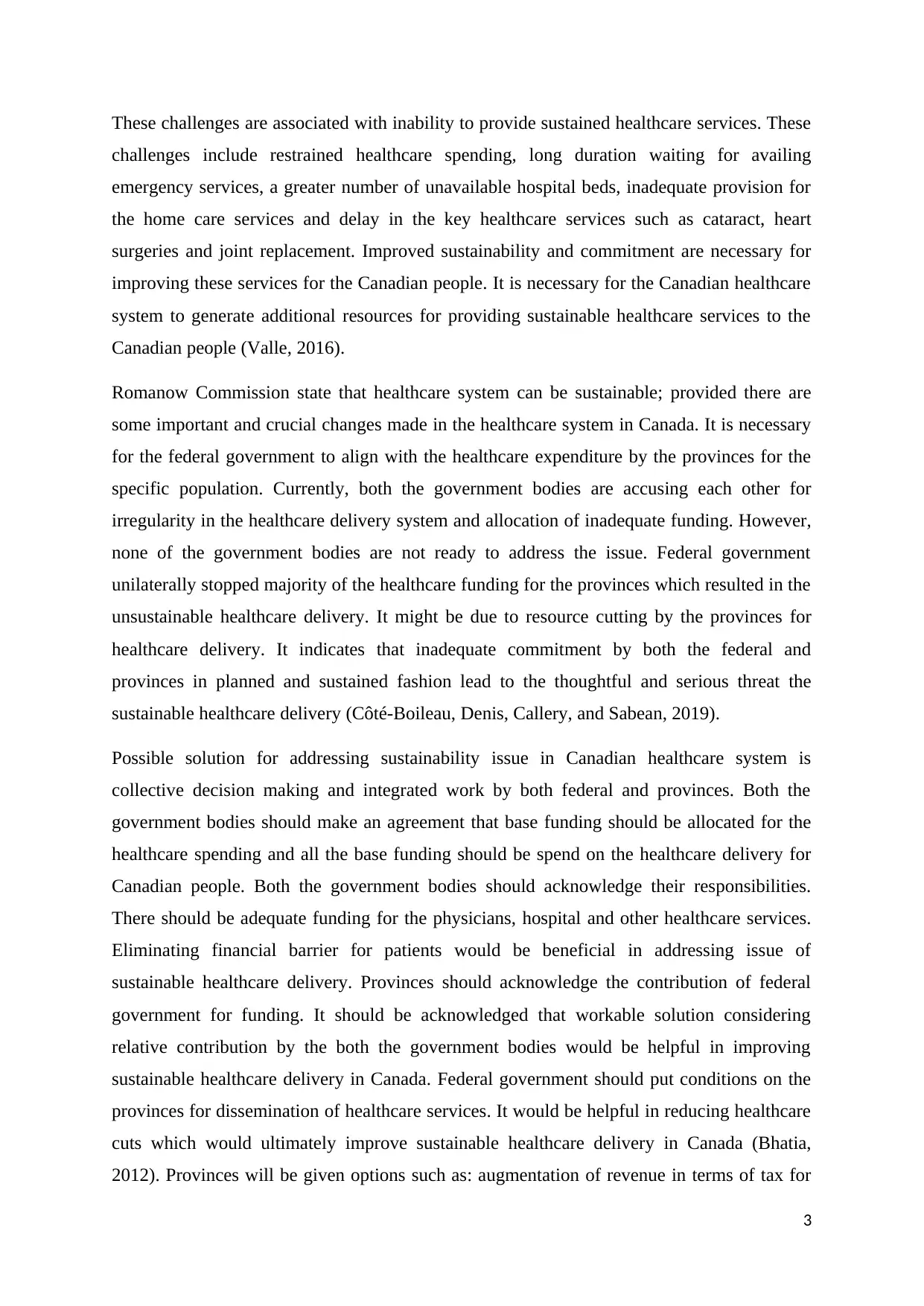
These challenges are associated with inability to provide sustained healthcare services. These
challenges include restrained healthcare spending, long duration waiting for availing
emergency services, a greater number of unavailable hospital beds, inadequate provision for
the home care services and delay in the key healthcare services such as cataract, heart
surgeries and joint replacement. Improved sustainability and commitment are necessary for
improving these services for the Canadian people. It is necessary for the Canadian healthcare
system to generate additional resources for providing sustainable healthcare services to the
Canadian people (Valle, 2016).
Romanow Commission state that healthcare system can be sustainable; provided there are
some important and crucial changes made in the healthcare system in Canada. It is necessary
for the federal government to align with the healthcare expenditure by the provinces for the
specific population. Currently, both the government bodies are accusing each other for
irregularity in the healthcare delivery system and allocation of inadequate funding. However,
none of the government bodies are not ready to address the issue. Federal government
unilaterally stopped majority of the healthcare funding for the provinces which resulted in the
unsustainable healthcare delivery. It might be due to resource cutting by the provinces for
healthcare delivery. It indicates that inadequate commitment by both the federal and
provinces in planned and sustained fashion lead to the thoughtful and serious threat the
sustainable healthcare delivery (Côté-Boileau, Denis, Callery, and Sabean, 2019).
Possible solution for addressing sustainability issue in Canadian healthcare system is
collective decision making and integrated work by both federal and provinces. Both the
government bodies should make an agreement that base funding should be allocated for the
healthcare spending and all the base funding should be spend on the healthcare delivery for
Canadian people. Both the government bodies should acknowledge their responsibilities.
There should be adequate funding for the physicians, hospital and other healthcare services.
Eliminating financial barrier for patients would be beneficial in addressing issue of
sustainable healthcare delivery. Provinces should acknowledge the contribution of federal
government for funding. It should be acknowledged that workable solution considering
relative contribution by the both the government bodies would be helpful in improving
sustainable healthcare delivery in Canada. Federal government should put conditions on the
provinces for dissemination of healthcare services. It would be helpful in reducing healthcare
cuts which would ultimately improve sustainable healthcare delivery in Canada (Bhatia,
2012). Provinces will be given options such as: augmentation of revenue in terms of tax for
3
challenges include restrained healthcare spending, long duration waiting for availing
emergency services, a greater number of unavailable hospital beds, inadequate provision for
the home care services and delay in the key healthcare services such as cataract, heart
surgeries and joint replacement. Improved sustainability and commitment are necessary for
improving these services for the Canadian people. It is necessary for the Canadian healthcare
system to generate additional resources for providing sustainable healthcare services to the
Canadian people (Valle, 2016).
Romanow Commission state that healthcare system can be sustainable; provided there are
some important and crucial changes made in the healthcare system in Canada. It is necessary
for the federal government to align with the healthcare expenditure by the provinces for the
specific population. Currently, both the government bodies are accusing each other for
irregularity in the healthcare delivery system and allocation of inadequate funding. However,
none of the government bodies are not ready to address the issue. Federal government
unilaterally stopped majority of the healthcare funding for the provinces which resulted in the
unsustainable healthcare delivery. It might be due to resource cutting by the provinces for
healthcare delivery. It indicates that inadequate commitment by both the federal and
provinces in planned and sustained fashion lead to the thoughtful and serious threat the
sustainable healthcare delivery (Côté-Boileau, Denis, Callery, and Sabean, 2019).
Possible solution for addressing sustainability issue in Canadian healthcare system is
collective decision making and integrated work by both federal and provinces. Both the
government bodies should make an agreement that base funding should be allocated for the
healthcare spending and all the base funding should be spend on the healthcare delivery for
Canadian people. Both the government bodies should acknowledge their responsibilities.
There should be adequate funding for the physicians, hospital and other healthcare services.
Eliminating financial barrier for patients would be beneficial in addressing issue of
sustainable healthcare delivery. Provinces should acknowledge the contribution of federal
government for funding. It should be acknowledged that workable solution considering
relative contribution by the both the government bodies would be helpful in improving
sustainable healthcare delivery in Canada. Federal government should put conditions on the
provinces for dissemination of healthcare services. It would be helpful in reducing healthcare
cuts which would ultimately improve sustainable healthcare delivery in Canada (Bhatia,
2012). Provinces will be given options such as: augmentation of revenue in terms of tax for
3
⊘ This is a preview!⊘
Do you want full access?
Subscribe today to unlock all pages.

Trusted by 1+ million students worldwide
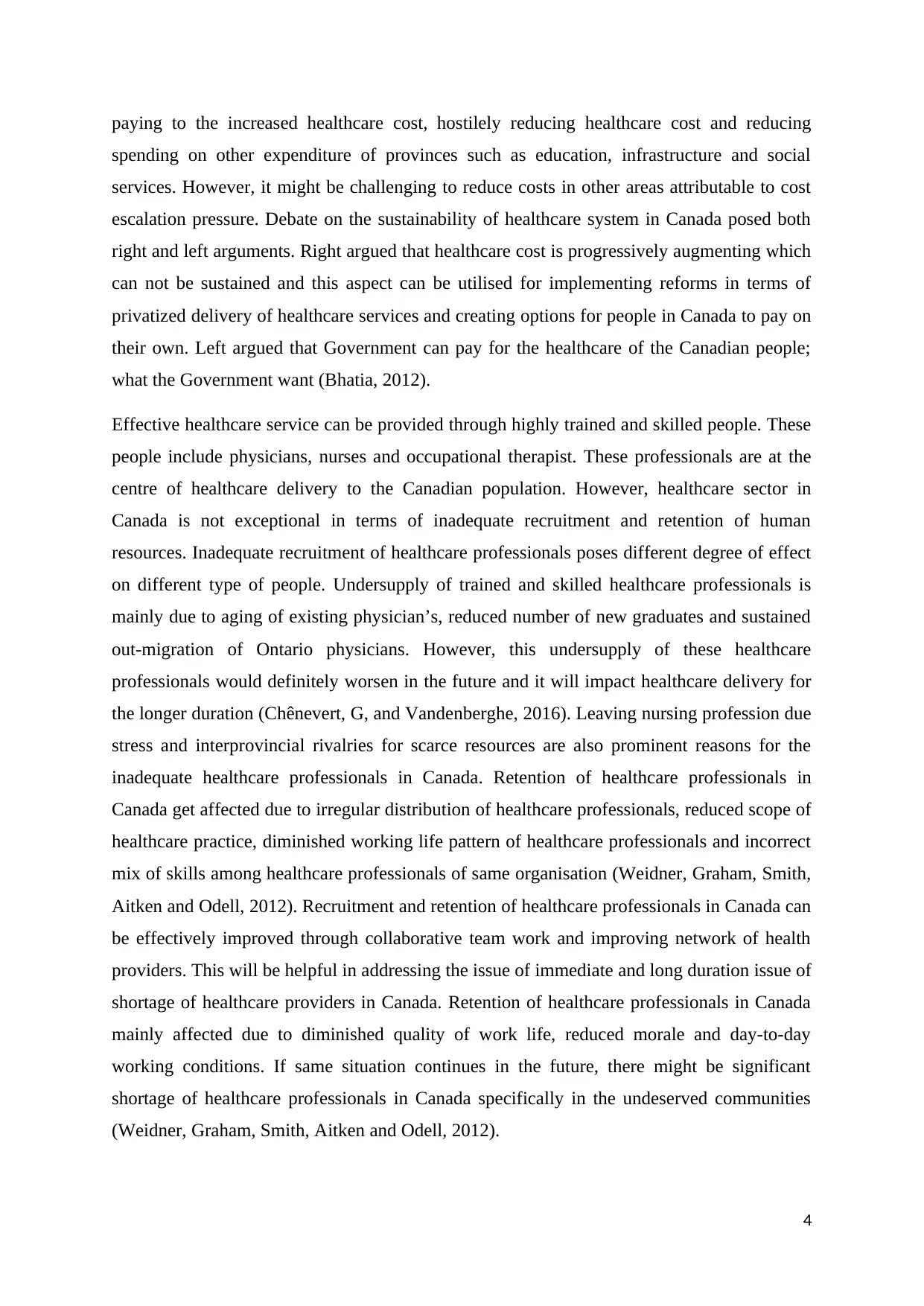
paying to the increased healthcare cost, hostilely reducing healthcare cost and reducing
spending on other expenditure of provinces such as education, infrastructure and social
services. However, it might be challenging to reduce costs in other areas attributable to cost
escalation pressure. Debate on the sustainability of healthcare system in Canada posed both
right and left arguments. Right argued that healthcare cost is progressively augmenting which
can not be sustained and this aspect can be utilised for implementing reforms in terms of
privatized delivery of healthcare services and creating options for people in Canada to pay on
their own. Left argued that Government can pay for the healthcare of the Canadian people;
what the Government want (Bhatia, 2012).
Effective healthcare service can be provided through highly trained and skilled people. These
people include physicians, nurses and occupational therapist. These professionals are at the
centre of healthcare delivery to the Canadian population. However, healthcare sector in
Canada is not exceptional in terms of inadequate recruitment and retention of human
resources. Inadequate recruitment of healthcare professionals poses different degree of effect
on different type of people. Undersupply of trained and skilled healthcare professionals is
mainly due to aging of existing physician’s, reduced number of new graduates and sustained
out-migration of Ontario physicians. However, this undersupply of these healthcare
professionals would definitely worsen in the future and it will impact healthcare delivery for
the longer duration (Chênevert, G, and Vandenberghe, 2016). Leaving nursing profession due
stress and interprovincial rivalries for scarce resources are also prominent reasons for the
inadequate healthcare professionals in Canada. Retention of healthcare professionals in
Canada get affected due to irregular distribution of healthcare professionals, reduced scope of
healthcare practice, diminished working life pattern of healthcare professionals and incorrect
mix of skills among healthcare professionals of same organisation (Weidner, Graham, Smith,
Aitken and Odell, 2012). Recruitment and retention of healthcare professionals in Canada can
be effectively improved through collaborative team work and improving network of health
providers. This will be helpful in addressing the issue of immediate and long duration issue of
shortage of healthcare providers in Canada. Retention of healthcare professionals in Canada
mainly affected due to diminished quality of work life, reduced morale and day-to-day
working conditions. If same situation continues in the future, there might be significant
shortage of healthcare professionals in Canada specifically in the undeserved communities
(Weidner, Graham, Smith, Aitken and Odell, 2012).
4
spending on other expenditure of provinces such as education, infrastructure and social
services. However, it might be challenging to reduce costs in other areas attributable to cost
escalation pressure. Debate on the sustainability of healthcare system in Canada posed both
right and left arguments. Right argued that healthcare cost is progressively augmenting which
can not be sustained and this aspect can be utilised for implementing reforms in terms of
privatized delivery of healthcare services and creating options for people in Canada to pay on
their own. Left argued that Government can pay for the healthcare of the Canadian people;
what the Government want (Bhatia, 2012).
Effective healthcare service can be provided through highly trained and skilled people. These
people include physicians, nurses and occupational therapist. These professionals are at the
centre of healthcare delivery to the Canadian population. However, healthcare sector in
Canada is not exceptional in terms of inadequate recruitment and retention of human
resources. Inadequate recruitment of healthcare professionals poses different degree of effect
on different type of people. Undersupply of trained and skilled healthcare professionals is
mainly due to aging of existing physician’s, reduced number of new graduates and sustained
out-migration of Ontario physicians. However, this undersupply of these healthcare
professionals would definitely worsen in the future and it will impact healthcare delivery for
the longer duration (Chênevert, G, and Vandenberghe, 2016). Leaving nursing profession due
stress and interprovincial rivalries for scarce resources are also prominent reasons for the
inadequate healthcare professionals in Canada. Retention of healthcare professionals in
Canada get affected due to irregular distribution of healthcare professionals, reduced scope of
healthcare practice, diminished working life pattern of healthcare professionals and incorrect
mix of skills among healthcare professionals of same organisation (Weidner, Graham, Smith,
Aitken and Odell, 2012). Recruitment and retention of healthcare professionals in Canada can
be effectively improved through collaborative team work and improving network of health
providers. This will be helpful in addressing the issue of immediate and long duration issue of
shortage of healthcare providers in Canada. Retention of healthcare professionals in Canada
mainly affected due to diminished quality of work life, reduced morale and day-to-day
working conditions. If same situation continues in the future, there might be significant
shortage of healthcare professionals in Canada specifically in the undeserved communities
(Weidner, Graham, Smith, Aitken and Odell, 2012).
4
Paraphrase This Document
Need a fresh take? Get an instant paraphrase of this document with our AI Paraphraser
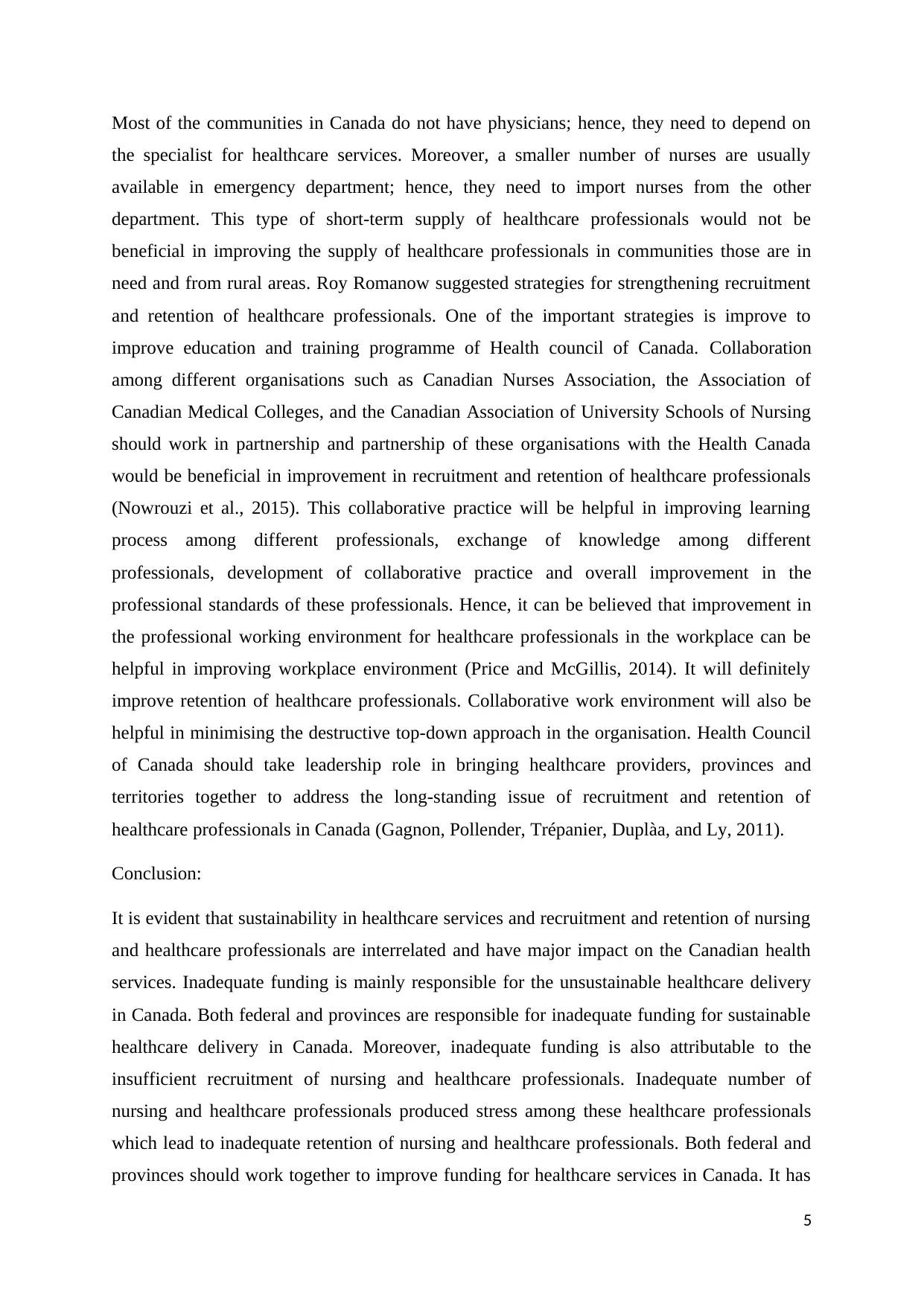
Most of the communities in Canada do not have physicians; hence, they need to depend on
the specialist for healthcare services. Moreover, a smaller number of nurses are usually
available in emergency department; hence, they need to import nurses from the other
department. This type of short-term supply of healthcare professionals would not be
beneficial in improving the supply of healthcare professionals in communities those are in
need and from rural areas. Roy Romanow suggested strategies for strengthening recruitment
and retention of healthcare professionals. One of the important strategies is improve to
improve education and training programme of Health council of Canada. Collaboration
among different organisations such as Canadian Nurses Association, the Association of
Canadian Medical Colleges, and the Canadian Association of University Schools of Nursing
should work in partnership and partnership of these organisations with the Health Canada
would be beneficial in improvement in recruitment and retention of healthcare professionals
(Nowrouzi et al., 2015). This collaborative practice will be helpful in improving learning
process among different professionals, exchange of knowledge among different
professionals, development of collaborative practice and overall improvement in the
professional standards of these professionals. Hence, it can be believed that improvement in
the professional working environment for healthcare professionals in the workplace can be
helpful in improving workplace environment (Price and McGillis, 2014). It will definitely
improve retention of healthcare professionals. Collaborative work environment will also be
helpful in minimising the destructive top-down approach in the organisation. Health Council
of Canada should take leadership role in bringing healthcare providers, provinces and
territories together to address the long-standing issue of recruitment and retention of
healthcare professionals in Canada (Gagnon, Pollender, Trépanier, Duplàa, and Ly, 2011).
Conclusion:
It is evident that sustainability in healthcare services and recruitment and retention of nursing
and healthcare professionals are interrelated and have major impact on the Canadian health
services. Inadequate funding is mainly responsible for the unsustainable healthcare delivery
in Canada. Both federal and provinces are responsible for inadequate funding for sustainable
healthcare delivery in Canada. Moreover, inadequate funding is also attributable to the
insufficient recruitment of nursing and healthcare professionals. Inadequate number of
nursing and healthcare professionals produced stress among these healthcare professionals
which lead to inadequate retention of nursing and healthcare professionals. Both federal and
provinces should work together to improve funding for healthcare services in Canada. It has
5
the specialist for healthcare services. Moreover, a smaller number of nurses are usually
available in emergency department; hence, they need to import nurses from the other
department. This type of short-term supply of healthcare professionals would not be
beneficial in improving the supply of healthcare professionals in communities those are in
need and from rural areas. Roy Romanow suggested strategies for strengthening recruitment
and retention of healthcare professionals. One of the important strategies is improve to
improve education and training programme of Health council of Canada. Collaboration
among different organisations such as Canadian Nurses Association, the Association of
Canadian Medical Colleges, and the Canadian Association of University Schools of Nursing
should work in partnership and partnership of these organisations with the Health Canada
would be beneficial in improvement in recruitment and retention of healthcare professionals
(Nowrouzi et al., 2015). This collaborative practice will be helpful in improving learning
process among different professionals, exchange of knowledge among different
professionals, development of collaborative practice and overall improvement in the
professional standards of these professionals. Hence, it can be believed that improvement in
the professional working environment for healthcare professionals in the workplace can be
helpful in improving workplace environment (Price and McGillis, 2014). It will definitely
improve retention of healthcare professionals. Collaborative work environment will also be
helpful in minimising the destructive top-down approach in the organisation. Health Council
of Canada should take leadership role in bringing healthcare providers, provinces and
territories together to address the long-standing issue of recruitment and retention of
healthcare professionals in Canada (Gagnon, Pollender, Trépanier, Duplàa, and Ly, 2011).
Conclusion:
It is evident that sustainability in healthcare services and recruitment and retention of nursing
and healthcare professionals are interrelated and have major impact on the Canadian health
services. Inadequate funding is mainly responsible for the unsustainable healthcare delivery
in Canada. Both federal and provinces are responsible for inadequate funding for sustainable
healthcare delivery in Canada. Moreover, inadequate funding is also attributable to the
insufficient recruitment of nursing and healthcare professionals. Inadequate number of
nursing and healthcare professionals produced stress among these healthcare professionals
which lead to inadequate retention of nursing and healthcare professionals. Both federal and
provinces should work together to improve funding for healthcare services in Canada. It has
5
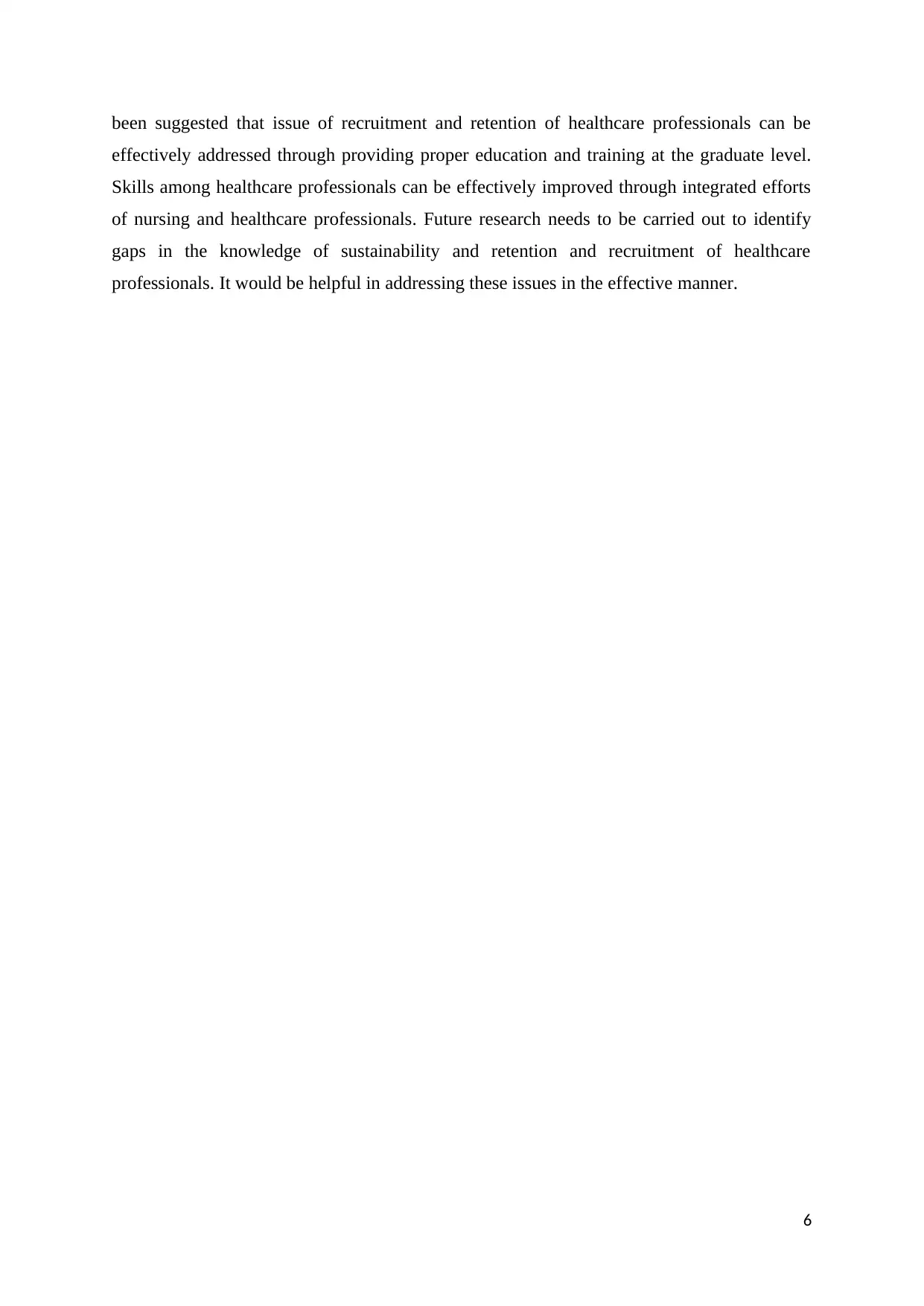
been suggested that issue of recruitment and retention of healthcare professionals can be
effectively addressed through providing proper education and training at the graduate level.
Skills among healthcare professionals can be effectively improved through integrated efforts
of nursing and healthcare professionals. Future research needs to be carried out to identify
gaps in the knowledge of sustainability and retention and recruitment of healthcare
professionals. It would be helpful in addressing these issues in the effective manner.
6
effectively addressed through providing proper education and training at the graduate level.
Skills among healthcare professionals can be effectively improved through integrated efforts
of nursing and healthcare professionals. Future research needs to be carried out to identify
gaps in the knowledge of sustainability and retention and recruitment of healthcare
professionals. It would be helpful in addressing these issues in the effective manner.
6
⊘ This is a preview!⊘
Do you want full access?
Subscribe today to unlock all pages.

Trusted by 1+ million students worldwide
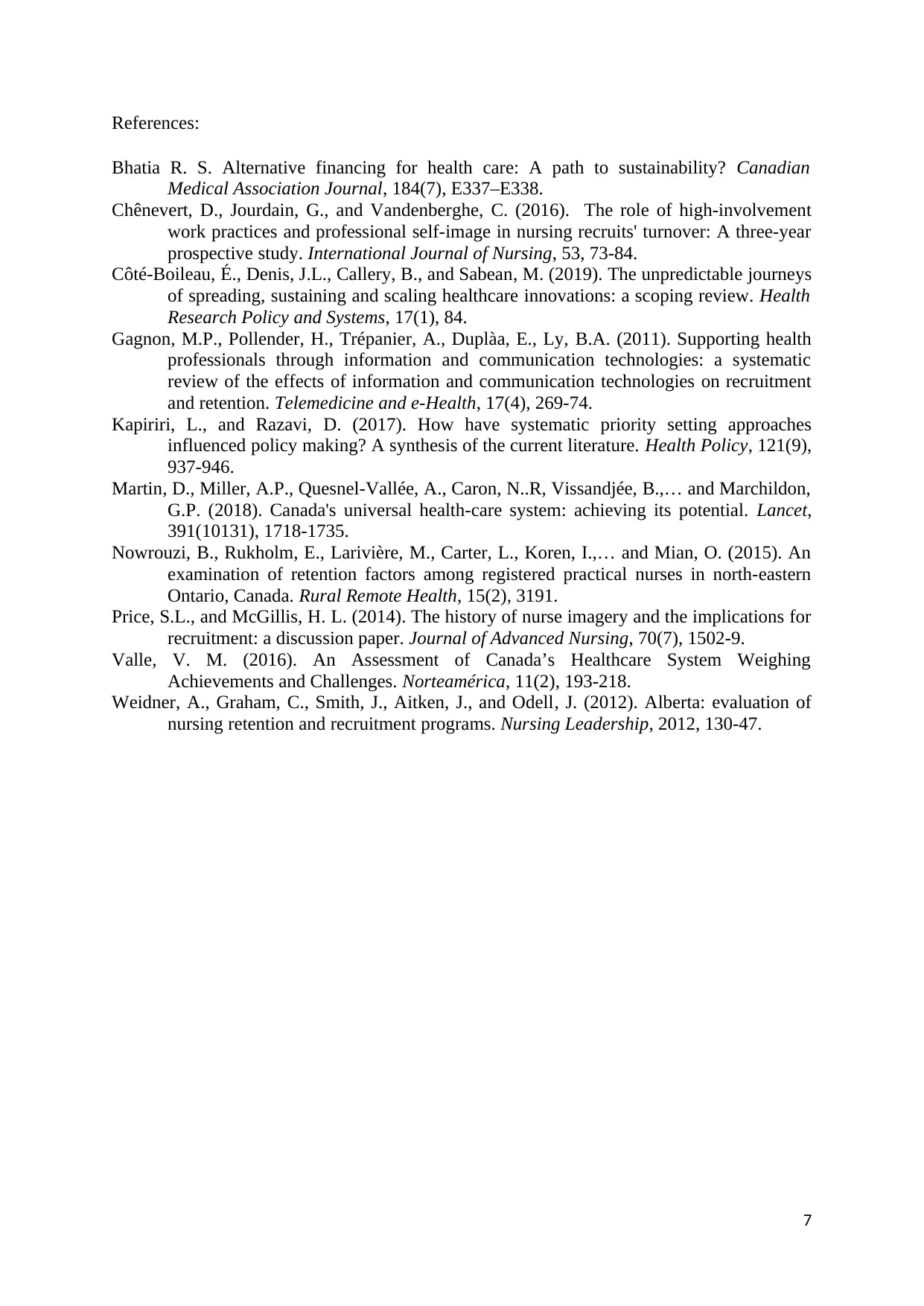
References:
Bhatia R. S. Alternative financing for health care: A path to sustainability? Canadian
Medical Association Journal, 184(7), E337–E338.
Chênevert, D., Jourdain, G., and Vandenberghe, C. (2016). The role of high-involvement
work practices and professional self-image in nursing recruits' turnover: A three-year
prospective study. International Journal of Nursing, 53, 73-84.
Côté-Boileau, É., Denis, J.L., Callery, B., and Sabean, M. (2019). The unpredictable journeys
of spreading, sustaining and scaling healthcare innovations: a scoping review. Health
Research Policy and Systems, 17(1), 84.
Gagnon, M.P., Pollender, H., Trépanier, A., Duplàa, E., Ly, B.A. (2011). Supporting health
professionals through information and communication technologies: a systematic
review of the effects of information and communication technologies on recruitment
and retention. Telemedicine and e-Health, 17(4), 269-74.
Kapiriri, L., and Razavi, D. (2017). How have systematic priority setting approaches
influenced policy making? A synthesis of the current literature. Health Policy, 121(9),
937-946.
Martin, D., Miller, A.P., Quesnel-Vallée, A., Caron, N..R, Vissandjée, B.,… and Marchildon,
G.P. (2018). Canada's universal health-care system: achieving its potential. Lancet,
391(10131), 1718-1735.
Nowrouzi, B., Rukholm, E., Larivière, M., Carter, L., Koren, I.,… and Mian, O. (2015). An
examination of retention factors among registered practical nurses in north-eastern
Ontario, Canada. Rural Remote Health, 15(2), 3191.
Price, S.L., and McGillis, H. L. (2014). The history of nurse imagery and the implications for
recruitment: a discussion paper. Journal of Advanced Nursing, 70(7), 1502-9.
Valle, V. M. (2016). An Assessment of Canada’s Healthcare System Weighing
Achievements and Challenges. Norteamérica, 11(2), 193-218.
Weidner, A., Graham, C., Smith, J., Aitken, J., and Odell, J. (2012). Alberta: evaluation of
nursing retention and recruitment programs. Nursing Leadership, 2012, 130-47.
7
Bhatia R. S. Alternative financing for health care: A path to sustainability? Canadian
Medical Association Journal, 184(7), E337–E338.
Chênevert, D., Jourdain, G., and Vandenberghe, C. (2016). The role of high-involvement
work practices and professional self-image in nursing recruits' turnover: A three-year
prospective study. International Journal of Nursing, 53, 73-84.
Côté-Boileau, É., Denis, J.L., Callery, B., and Sabean, M. (2019). The unpredictable journeys
of spreading, sustaining and scaling healthcare innovations: a scoping review. Health
Research Policy and Systems, 17(1), 84.
Gagnon, M.P., Pollender, H., Trépanier, A., Duplàa, E., Ly, B.A. (2011). Supporting health
professionals through information and communication technologies: a systematic
review of the effects of information and communication technologies on recruitment
and retention. Telemedicine and e-Health, 17(4), 269-74.
Kapiriri, L., and Razavi, D. (2017). How have systematic priority setting approaches
influenced policy making? A synthesis of the current literature. Health Policy, 121(9),
937-946.
Martin, D., Miller, A.P., Quesnel-Vallée, A., Caron, N..R, Vissandjée, B.,… and Marchildon,
G.P. (2018). Canada's universal health-care system: achieving its potential. Lancet,
391(10131), 1718-1735.
Nowrouzi, B., Rukholm, E., Larivière, M., Carter, L., Koren, I.,… and Mian, O. (2015). An
examination of retention factors among registered practical nurses in north-eastern
Ontario, Canada. Rural Remote Health, 15(2), 3191.
Price, S.L., and McGillis, H. L. (2014). The history of nurse imagery and the implications for
recruitment: a discussion paper. Journal of Advanced Nursing, 70(7), 1502-9.
Valle, V. M. (2016). An Assessment of Canada’s Healthcare System Weighing
Achievements and Challenges. Norteamérica, 11(2), 193-218.
Weidner, A., Graham, C., Smith, J., Aitken, J., and Odell, J. (2012). Alberta: evaluation of
nursing retention and recruitment programs. Nursing Leadership, 2012, 130-47.
7
1 out of 7
Related Documents
Your All-in-One AI-Powered Toolkit for Academic Success.
+13062052269
info@desklib.com
Available 24*7 on WhatsApp / Email
![[object Object]](/_next/static/media/star-bottom.7253800d.svg)
Unlock your academic potential
Copyright © 2020–2025 A2Z Services. All Rights Reserved. Developed and managed by ZUCOL.





